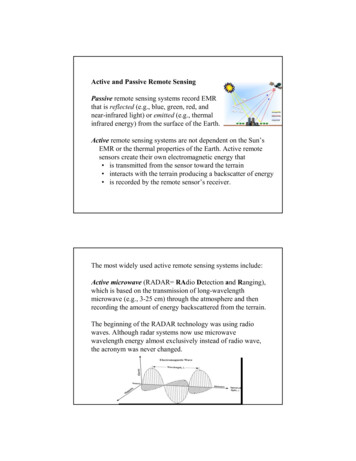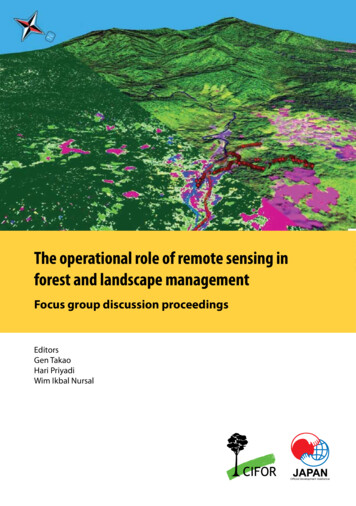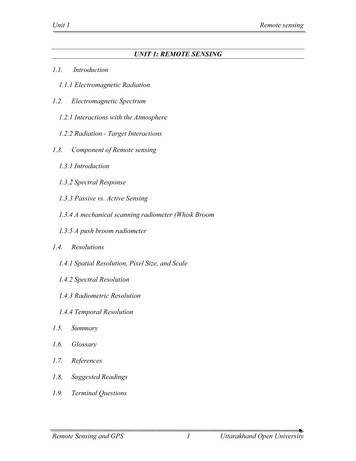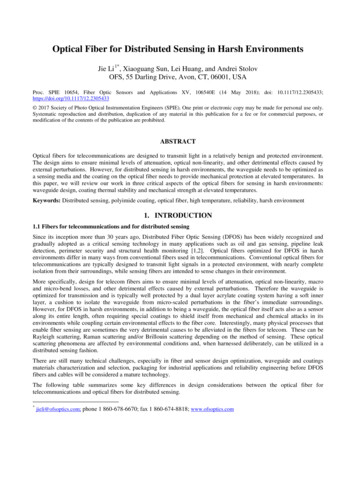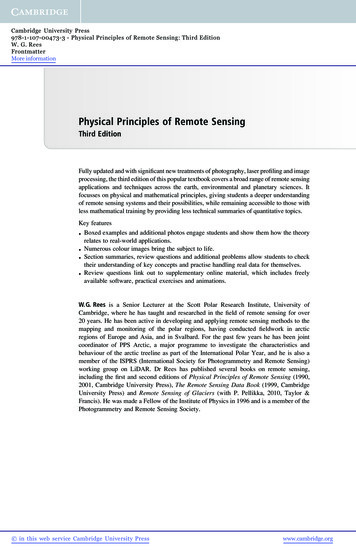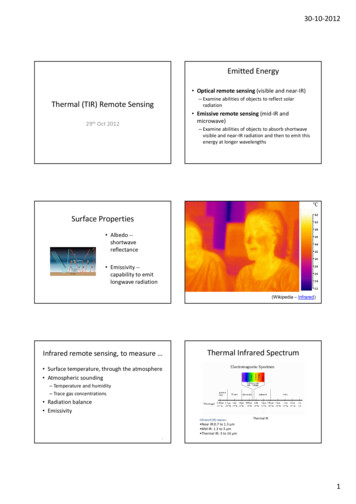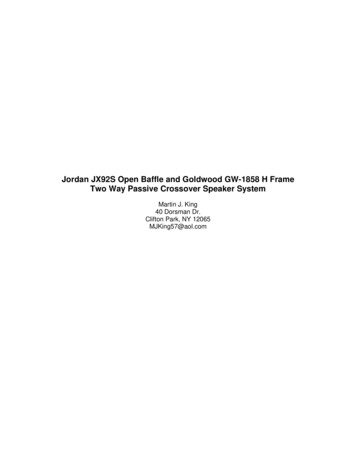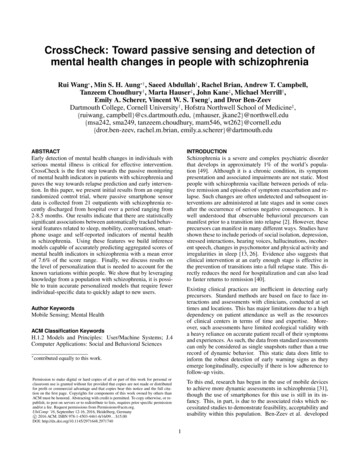
Transcription
CrossCheck: Toward passive sensing and detection ofmental health changes in people with schizophreniaRui Wang , Min S. H. Aung † , Saeed Abdullah† , Rachel Brian, Andrew T. Campbell,Tanzeem Choudhury† , Marta Hauser‡ , John Kane‡ , Michael Merrill† ,Emily A. Scherer, Vincent W. S. Tseng† , and Dror Ben-ZeevDartmouth College, Cornell University† , Hofstra Northwell School of Medicine‡ ,{ruiwang, campbell}@cs.dartmouth.edu, {mhauser, jkane2}@northwell.edu{msa242, sma249, tanzeem.choudhury, mam546, wt262}@cornell.edu{dror.ben-zeev, rachel.m.brian, Early detection of mental health changes in individuals withserious mental illness is critical for effective intervention.CrossCheck is the first step towards the passive monitoringof mental health indicators in patients with schizophrenia andpaves the way towards relapse prediction and early intervention. In this paper, we present initial results from an ongoingrandomized control trial, where passive smartphone sensordata is collected from 21 outpatients with schizophrenia recently discharged from hospital over a period ranging from2-8.5 months. Our results indicate that there are statisticallysignificant associations between automatically tracked behavioral features related to sleep, mobility, conversations, smartphone usage and self-reported indicators of mental healthin schizophrenia. Using these features we build inferencemodels capable of accurately predicting aggregated scores ofmental health indicators in schizophrenia with a mean errorof 7.6% of the score range. Finally, we discuss results onthe level of personalization that is needed to account for theknown variations within people. We show that by leveragingknowledge from a population with schizophrenia, it is possible to train accurate personalized models that require fewerindividual-specific data to quickly adapt to new users.Schizophrenia is a severe and complex psychiatric disorderthat develops in approximately 1% of the world’s population [49]. Although it is a chronic condition, its symptompresentation and associated impairments are not static. Mostpeople with schizophrenia vacillate between periods of relative remission and episodes of symptom exacerbation and relapse. Such changes are often undetected and subsequent interventions are administered at late stages and in some casesafter the occurrence of serious negative consequences. It iswell understood that observable behavioral precursors canmanifest prior to a transition into relapse [2]. However, theseprecursors can manifest in many different ways. Studies haveshown these to include periods of social isolation, depression,stressed interactions, hearing voices, hallucinations, incoherent speech, changes in psychomotor and physical activity andirregularities in sleep [13, 26]. Evidence also suggests thatclinical intervention at an early enough stage is effective inthe prevention of transitions into a full relapse state. This directly reduces the need for hospitalization and can also leadto faster returns to remission [40].Existing clinical practices are inefficient in detecting earlyprecursors. Standard methods are based on face to face interactions and assessments with clinicians, conducted at settimes and locations. This has major limitations due to a highdependency on patient attendance as well as the resourcesof clinical centers in terms of time and expertise. Moreover, such assessments have limited ecological validity witha heavy reliance on accurate patient recall of their symptomsand experiences. As such, the data from standard assessmentscan only be considered as single snapshots rather than a truerecord of dynamic behavior. This static data does little toinform the robust detection of early warning signs as theyemerge longitudinally, especially if there is low adherence tofollow-up visits.Author KeywordsMobile Sensing; Mental HealthACM Classification KeywordsH.1.2 Models and Principles: User/Machine Systems; J.4Computer Applications: Social and Behavioral Sciences contributed equally to this work.Permission to make digital or hard copies of all or part of this work for personal orclassroom use is granted without fee provided that copies are not made or distributedfor profit or commercial advantage and that copies bear this notice and the full citation on the first page. Copyrights for components of this work owned by others thanACM must be honored. Abstracting with credit is permitted. To copy otherwise, or republish, to post on servers or to redistribute to lists, requires prior specific permissionand/or a fee. Request permissions from Permissions@acm.org.UbiComp ’16, September 12-16, 2016, Heidelberg, Germanyc 2016 ACM. ISBN 978-1-4503-4461-6/16/09. . . 15.00DOI: http://dx.doi.org/10.1145/2971648.2971740To this end, research has begun in the use of mobile devicesto achieve more dynamic assessments in schizophrenia [31],though the use of smartphones for this use is still in its infancy. This, in part, is due to the associated risks which necessitated studies to demonstrate feasibility, acceptability andusability within this population. Ben-Zeev et al. developed1
is essential for addressing mental health states that have lowfrequency changes taking days, weeks or even months [4, 32,50].the FOCUS self management app [6] that provides illnessself-management suggestions and interventions in responseto participants’ rating of their clinical status and functioning.This system received high acceptance rates among users andis shown to be usable by this population [7]. A pilot study inthe efficacy of tracking patients [9] over two weeks shows thatsensing using smartphones is acceptable to both inpatientsand outpatients. These results paves the way for new sensingand inference systems to passively monitor and detect mentalhealth changes using commercially available smartphones.There has been no prior work in the prediction of changes inmental health using passive sensing data from smartphones inschizophrenia. Previous work conducted in populations withdepression and bipolar disorder informs our schizophreniafocused efforts. For depression, early work by [17] uses location, social interaction, activity and mood inferred from arange of sensors to assess depression. Saeb et al. [45] explorethe relationships between a wide range of features derivedfrom sensing and show that variation in location as well asphone usage significantly correlates with depressive symptoms. Canzian and Musolei [19] show significant correlations between various measures of mobility derived from location traces with depressive mood. In modeling bipolar disorder, the findings reported in [1] show the automatic inference of circadian stability as a measure to support effectivebipolar management. The MONARCA project [41] demonstrate correlations between accelerometer based activity levels over different periods of the day and psychiatric evaluationscores for the mania-depression spectrum. Maxuni et al. [38]add to this by utilizing speech along with activity levels tosuccessfully classify stratified levels of bipolar disorder. Forstress detection, [35] detects stress with 0.76 accuracy usingacoustic features. Other studies investigate the use of locationinformation [5], measures of social interaction derived fromphone-call, SMS, and proximity data [14] to detect stress.In [29, 46, 47], the authors demonstrate using features fromboth smartphones and wearables to detect and track stress.In this paper, we analyze preliminary data from a randomizedcontrol trial of CrossCheck, a smartphone sensing systemcurrently deployed to outpatients with schizophrenia. CrossCheck is the first system to use continuous passive sensingand periodic self-reports to monitor and assess mental healthchanges in schizophrenia. The ultimate goal of the project isto develop sensing, inference and analysis techniques capableof dynamically assessing mental health changes and predicting the risk of relapse without the need for retrospective recallor self-reports. Another future aim of CrossCheck is to implement new invention techniques to automatically alert clinicians in time to prevent or reduce the severity of relapse. Inthis paper, we are not directly addressing relapse or intervention, but take a first step towards these goals by investigating:(i) the relationships between passively tracked behavior andself-reported measures, and (ii) how much personalization ofthe system is required given the observed variability betweenindividual patients.Specifically, the contributions of this exploratory study are: CrossCheck, the first system to use passive sensing data tomonitor and predict indicators of mental health for 21 outpatients diagnosed with schizophrenia recently dischargedfrom hospital; CrossCheck monitors these outpatients forperiods between 64 and 254 days.The use of smartphone data has also been used to modelbroader measures of well being over long periods. In [43]the authors demonstrate that speech and conversation occurrences extracted from audio data and physical activity infermental and social well being. The Studentlife [50] study investigates correlations between conversation, sleep, activityand co-location with a range of wellness scores relating tostress, loneliness, flourishing and depression within the context of a university campus over a single term. This led onfrom BeWell [33], which inferred sleep, social interaction andactivity from smartphones, as a means of promoting wellness. Meaningful associations between passively tracked dataand indicators or dimensions of mental health in peoplewith schizophrenia (e.g., stressed, depressed, calm, hopeful, sleeping well, seeing things, hearing voices, worryingabout being harmed) to better understand the behavioralmanifestation of these measures and eventually develop areal-time monitoring and relapse prevention system.CROSSCHECK STUDY DESIGN Models that can predict participants’ aggregated ecologicalmomentary assessment (EMA) scores that measure severaldynamic dimensions of mental health and functioning inpeople with schizophrenia.The CrossCheck study is a randomized control trial (RCT)[20] conducted in collaboration with a large psychiatric hospital in Long Island, NY. The study aims to recruit 150 participants for 12 months using rolling enrollment. The participants are randomized to one of two arms: CrossCheck(n 75) or treatment-as-usual (n 75). The participants fromthe CrossCheck smartphone arm enrolled to date are the focus of this paper. We report on inferring indicators of mentalhealth and not relapse prediction as there is only a small number of relapses cases (7) observed at present. Given previousdata on this type of study population, we expect that at the endof the year long RCT there will be a larger cohort of patientsthat have experienced relapse to make robust relapse prediction viable.The study has been approved by the Committeesfor the Protection of Human Subjects at Dartmouth College Level of personalization that is needed to account for theknown variations within people. We show that by leveraging knowledge from a population with schizophrenia, itis possible to train personalized models that require fewerindividual-specific data to quickly adapt to a new user.RELATED WORKThere is growing interest in using smartphones to monitor andassess wellbeing and mental health [23]. Smartphones area natural platform to monitor and assess behavioral patternsthat manifest over long periods. Such longitudinal tracking2
durations). The app also collects audio amplitude, accelerometer readings, light sensor readings, location coordinates, andapplication usages. CrossCheck uses a built in MobileEMAmodule [50] to administer EMAs [9]. During the collection phase, participants are asked to respond to EMA questions every Monday, Wednesday, and Friday (see CrossCheckDataset). This paper focuses on the EMA data as symptommeasures. CrossCheck is published in Google Play Store’sbeta testing channel to control access. Google Play Store isused to remotely update the sensing system when necessary.The inferences, the sensor data, and the EMA responses aretemporarily stored on the phone and are efficiently uploadedto a secured server when users recharge their phones. Figure 2 gives an overview of the data collection and analysisworkflow.and Human Services and the Institutional Review Board atZucker Hillside Hospital. In what follows, we discuss participant recruitment, the sensing system, and the detailed studyprocedure.Identifying ParticipantsThe study hospital’s Electronic Medical Record is used toidentify potential study candidates who are then approachedby a staff member to gauge their interest in the study. If interested, a research interview is scheduled. Research flyers arealso posted at the study site with the research coordinator’sphone number. A candidate is a patient who is 18 or older,met DSM-IV or DSM-V criteria for schizophrenia, schizoaffective disorder or psychosis, and had psychiatric hospitalization, daytime psychiatric hospitalization, outpatient crisismanagement, or short-term psychiatric hospital emergencyroom visits within 12 months before study entry. The candidate should be able to use smartphones and have at least 6thgrade reading determined by the Wide Range AchievementTest 4 [51]. Individuals with a legal guardian are excluded.Data collection monitoring. CrossCheck includes management scripts that automatically produce statistics on compliance. It sends a daily report on how many hours of sensordata had been collected for the last few days. The daily reportlabels participants who have not uploaded any data. CrossCheck also sends out weekly reports with visualizations ofparticipants’ sensing data (e.g., distance traveled, sleep andconversation duration) and EMA responses for the most recent week. Daily reports and weekly reports help researchersto identify participants who are collecting data or are havingproblems with the system. Research staff would call noncompliant participants to give assistance and get them backon track.Recruiting ParticipantsThe staff at the recruitment hospital first screened candidatesbased on criteria described in Identifying Participants. Thenthe staff contacted candidates in person at the study site or byphone to provide a complete description of the study. Interested individuals review the consent form with study staff andare administered a competency screener to verify that theyunderstand what is being asked of them and are able to provide informed consent. After consent, enrolled participantsare administered the baseline assessment, then are randomlyassigned to CrossCheck or the treatment-as-usual arm whereno sensing is done. Participants in the smartphone arm areloaned a Samsung Galaxy S5 Android phone equipped withthe CrossCheck app and receive a tutorial on how to use thephone. To ensure the acquired data has a broad coverage ofbehaviors, participants personal phone numbers are migratedto the new phone and they are provided with an unlimiteddata plan for data uploading. Participants are asked to keepthe phone turned on and to carry it with them as they go abouttheir day and charge it close to where they sleep at night. Asof February 2, 2016, 48 participants are randomized to theCrossCheck arm, with 14 who dropped out. The primary reason for dropping out is due to leaving treatment at the studysite. A few participants dropped out due to not being interested in participating anymore. In the 34 remaining, 17 participants are females and 17 are males (11 African American,2 Asian, 19 Caucasian, 1 Multiracial and 1 did not disclose).Privacy considerations. In order to protect participants’ personal information, each participant is given a random studyID. Any identifiable information is stored securely in lockedcabinets and secured servers. The participant’s personal information, such as phone number and email address, is notcollected by the sensing app. Participants’ data is uploadedto a secured server using encrypted SSL connections. If aparticipant’s phone is lost we remotely erase the data on thephone and reset it.CROSSCHECK DATASETThe dataset includes behavioral features and inferences fromraw sensor data, EMA responses, and combined indicatorscores calculated from EMA responses. We select behavioralfeatures based on participants’ behaviors (e.g., physical activity, sociability, sleep , mobility) that are associated withdimensions of mental health state [1,19,33,38,41,43,45,50].We use self-reported EMA data as mental health state indicators of schizophrenia patients.CrossCheck SystemThe CrossCheck sensing system is built based on our priorsensing work [1, 33, 50] that uses smartphone sensing andself-report tools. Compared with the StudentLife sensingsystem [50], the CrossCheck app uses the Android activityrecognition API instead of the self developed classifier to infer activities. The CrossCheck app collects sensor data continuously and does not require the participant’s interaction.The CrossCheck app automatically infers activity (stationary,walking, running, driving, cycling), sleep duration, and sociability (i.e., the number of independent conservations and theirTimescale and EpochsBehavioral features are computed on a daily basis. For example, the daily conversation frequency is the number of conversations a participant is around over a 24-hour period. Inaddition, a day is partitioned evenly into four epochs: morning (6 am to 12 pm), afternoon (12 pm to 6 pm), evening (6pm to 12 am), and night (12 am to 6 am), we also compute behavioral features for these four epochs to explore behavioralpatterns within different phases in a day.3
method [37] with a minimum of ten points per cluster anda minimum cluster radius of ten meters over the entirety ofa single user’s data. The first and second largest clusters arelabeled as the primary and secondary locations, respectively.Behavioral Sensing FeaturesA wide range of behavioral sensing features from the raw sensor data and behavioral inferences are collected by the CrossCheck app. These features describe patterns of participants’physical activity, sociability, mobility, phone usage, sleep,and the characteristics of the ambient environment in whichthe participant dwells. Below, we discuss these features andthe rationale behind using them for our analysis.Phone and app usage. User interaction with the phone ispotentially indicative of general daily function. For a coarsemeasure, we compute the number of times the phone is unlocked per day, as well as the duration in which the phoneis unlocked per day and within each of the four epochs. Wealso create more nuanced measures by leveraging informationabout the types of apps that are running. Given the wide variety of apps, we classify each app into one of the three broadcategories: social, engagement, and entertainment. Thesecategories were chosen as they are indicative of sociabilityand daily function which in turn may potentially be indicative of mental health changes. We use the meta-informationfrom Google Play’s categorizations and bin all active appsinto one of the three categories. The social category is a combination of social and communication apps, examples includeFacebook and Twitter. The engagement category consists ofhealth & fitness, medical, productivity, transportation and finance apps, examples include Calendar and Runkeeper. Theentertainment category consists of news & magazines, media& video, music & audio, and entertainment apps. Examplesof apps in this category are YouTube and NetFlix. We compute the total number of apps that belong to each of thesethree categories every 15 minutes from the process stack. Wethen calculate the increases in the number of apps that belongto each category which is indicative of how often the participant launches an app in one of the categories.Activity. We use the Android activity recognition API thatincludes: on foot, still, in vehicle, on bicycle, tilting, and unknown. CrossCheck gives an activity update every 10 seconds when the user is moving, or every 30 minutes whenthe user is stationary. We compute the durations of stationary state and walking states per day and within each of thefour epochs as physical activity features. Our scale evaluation shows that the Android activity recognition API inferswalking and stationary with 95% accuracy.Speech and conversation. Previous studies [33, 43, 50] haveshown that the detection of conservations and human voiceis related to wellness and mental health. We compute thenumber and duration of detected conversational episodes perday and over each of the four epochs. We also compute thenumber of occurrences of human voice and non human voicealong with their respective durations per day.Calls and SMS. To further inform the level of social interaction and communication we consider phone calls and SMSactivities. We compute the number and duration of incomingand outgoing calls over a day and the number of incomingand outgoing SMS.Ambient environment. We compute features to measure theambient sound and light environment. The mean levels ofambient volume per day and within four epochs reflect theambient context of the participant’s acoustic environment, forexample quiet isolated places versus noisy busy places. Similarly, we consider the ambient light levels to get more information about the environmental context of the participant,for example dark environment versus well illuminated environment. We acknowledge that the phone cannot detect theambient light when in the pocket. However, we found thatthe phone can opportunistically sense the ambient light environment that can be used to help infer sleep [21]. We use themean illumination over a day and within the four epochs.Sleep. Changes in sleep pattern or the onset of unusual sleepbehavior may indicate changes in mental health [13]. Sleeprelated features that are derived from the sleep inferences are:overall duration of sleep, going to sleep time, and wake timefor each day [21, 50].Location. Prior studies have shown that a user’s mobilitypatterns from geo-location traces are associated with mentalhealth and wellness [19, 45, 50]. In schizophrenia, for example, it is not uncommon for people to be isolated and stay athome with little external contact especially when individualsare experiencing distressing psychotic symptoms. We calculate the following set of location features on a daily basis:total distance traveled, maximum distance travelled betweentwo tracked points, maximum displacement from the home,standard deviation of distances, location entropy, duration oftime spent at primary location, duration of time spent at secondary location. Finally, we compute a locational routine index over seven days to quantify the degree of repetition interms of places visited with respect to the time of day over aspecific period of time. These features stem from the workson depression in [19, 45]. Further we propose the numberof new places visited in a day by using the number of newlocations in a day that have not been seen previously. Sampled location readings/coordinates are clustered in to primary,secondary or other location using the DBSCAN clusteringEcological Momentary AssessmentsThere are several dynamic dimensions of mental health andfunctioning in people with schizophrenia that are of interest.These include items such as visual and auditory hallucinations, incoherent speech delusion, social dysfunction or withdrawal, disorganized behavior, and inappropriate affect [3].Other possible indicators of changes in mental health includevariations in sleep, depressive mood and stress. EMA hasshown to be a valid approach to capture mental health statesamongst people with schizophrenia [27]. The set of EMAquestions we use in CrossCheck are based on self-reported dimensions defined in previous schizophrenia research [8]. TheEMA has 10 questions, which can be grouped into two cat4
Data cleaning. Given that our analysis is based on data thatare aggregated over a day (e.g., distance traveled during aday), missing data during a day would skew derived valuesand may misrepresent behavior. Therefore, the proportion ofthree forms of continuously sampled data (activity, location,and audio) are used to determine how many hours of data issensed in a day. Days with fewer than 19 hours of sensingdata are discarded. Since recruitment of outpatients and datacollection is an ongoing process, participants join the studyat different times leading to varying amounts of data. We include participants who have been in the study for longer periods and are compliant when answering EMAs. Specifically,we select participants who have more than 60 days of sensordata as of February 2nd 2016 and completed at least 50% ofthe EMAs. 21 out of 34 participants in the CrossCheck arm ofthe RCT satisfy this criteria. As a result we analyze 2809 daysof sensing data and 1778 EMA responses for 21 participants.All participants are in the study for a minimum of 64 days.The total number of days ranges from 64 to 254 days. On average, each participant in the study provides 133.76 days (19weeks) of sensing data and 84.7 EMA responses.egories: positive item questions and negative item questions.Higher score in positive questions indicates better outcomeswhereas higher scores in negative item questions indicatesworse outcomes. Positive questions ask a participant if theyhave been feeling calm, been social, been sleeping well, beenable to think clearly, and been hopeful about the future. Negative questions ask a participant if they have been depressed,been feeling stressed, been bothered by voices, been seeingthings other people can’t see, and been worried about beingharmed by other people. The questions are framed as simpleone sentence questions with a 0-3 multiple choice answers(for specific phrasing see Table 1). The MobileEMA user interface is designed to be simple and easy to use. It shows thequestions one by one. The participant responds to the question by touching a big button associated with their response.We calculate the EMA negative score, positive score, and sumscore from the responses. The EMA positive score is the sumof all positive questions’ score, the negative score is the sumof all negative questions’ score, and the sum score is the positive score minus the negative score. The positive and negativescore range from 0 to 15 and the sum score ranges from -15and 15.Data preparation. Given that the EMA module launches aset of questions every 2-3 days, we aggregate the sensed datafrom the days within this interval by taking the mean. Figure 1 shows the daily data aggregation strategy used to predict EMA scores. For example, if a participant gave EMAresponses on day 3, 6, and 9, we compute the mean of eachfeature data (e.g., the mean sleep duration and the mean distanced traveled) from day 1 to 3 to predict the EMA score atday 3, the mean from day 4 to 6 to predict the EMA score atday 6, and the mean from day 7 to 9 to predict the EMA onday 9.Table 1: EMA questions related indicators of mental healthHave you been feeling CALM?Have you been SOCIAL?Have you been bothered by VOICES?Have you been SEEING THINGS other people can’t see?Have you been feeling STRESSED?Have you been worried about people trying to HARM you?Have you been SLEEPING well?Have you been able to THINK clearly?Have you been DEPRESSED?Have you been HOPEFUL about the future?Options: 0- Not at all; 1- A little; 2- Moderately; 3- Extremely.EMAaverageANALYSIS AND RESULTSaverageaveragesensingWe identify a number of important associations betweenphone-based behavioral features described in CrossCheckDataset and dynamic dimensions of mental health and functioning in terms of EMA scores (e.g., feeling depressed, hearing voices or thinking clearly). Also in this section, wepresent results on the use of predictive models on aggregatedEMA scores. We test the level of personalization needed foraccurate modeling and for predicting longer term underlyingtrends in the scores.daysFigure 1: Feature/EMA preparationFeature Space VisualizationTo gain an insight into the feature space, the data fromall participants is mapped using the t-Distributed Stochastic Neighbor Embedding (t-SNE) [36] method. The tSNE [36] is an emerging technique for dimensionality reduction that is particularly well suited to visualize highdimensional datasets. It projects each high-dimensional datapoint to a two-dimensional point such that similar data pointsin the high-dimensional space are projected to nearby pointsin the two-dimensional space and dissimilar data points areprojected to distant points. The feature visualization is shownin Figure 3.Methods overviewWe first run bivariate regression analysis to understand associations between the measures of interest in schizophreniafrom the EMA scores and passively tracked behavioral features. The regression results are presented in Bivariate Regression Analysis. We then run prediction analysis using Gradient Boosted Regression Trees (GBRT) [25, 42] to evaluatethe feasibility of predicting EMA sum scores, which is discussed in Prediction Analysis. Finally, we generate personspecific models using Random Forest (RF) [15] to gain insight into predicting smoothed EMA sum scores that characterize underlying trends.Figure 3(a) shows the mapped features on a two-dimensionalspace. Each data point represents a subject’s behavioral features used to predict EMA responses. We observe data pointsare grouped into different clusters. By color-coding eachpoint per participant, it can be clearly seen that each clusteris predominantly participant specific. This important finding5
veModellingStructuralMappingSleepAndroid Phone1001005050projected yCalmEMADepressedVoicesSeeing ThingsHopefulThinking ClearlySocialSleeping WellHarmStressedBehavioralClassifiersActivityproje
The use of smartphone data has also been used to model broader measures of well being over long periods. In [43] the authors demonstrate that speech and conversation occur-rences extracted from audio data and physical activity infer mental and social well being. The Studentlife [50] study in-vestigates correlations between conversation, sleep .

